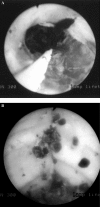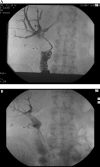Percutaneous endoscopic holmium laser lithotripsy for management of complicated biliary calculi
- PMID: 19660213
- PMCID: PMC3015947
Percutaneous endoscopic holmium laser lithotripsy for management of complicated biliary calculi
Abstract
Background and objectives: Advances in endoscopic techniques have transformed the management of urolithiasis. We sought to evaluate the role of such urological interventions for the treatment of complex biliary calculi.
Methods: We conducted a retrospective review of all patients (n=9) undergoing percutaneous holmium laser lithotripsy for complicated biliary calculi over a 4-year period (12/2003 to 12/2007). All previously failed standard techniques include ERCP with sphincterotomy (n=6), PTHC (n=7), or both of these. Access to the biliary system was obtained via an existing percutaneous transhepatic catheter or T-tube tracts. Endoscopic holmium laser lithotripsy was performed via a flexible cystoscope or ureteroscope. Stone clearance was confirmed intra- and post-operatively. A percutaneous transhepatic drain was left indwelling for follow-up imaging.
Results: Mean patient age was 65.6 years (range, 38 to 92). Total stone burden ranged from 1.7 cm to 5 cm. All 9 patients had stones located in the CBD, with 2 patients also having additional stones within the hepatic ducts. All 9 patients (100%) were visually stone-free after one endoscopic procedure. No major perioperative complications occurred. Mean length of stay was 2.4 days. At a mean radiological follow-up of 5.4 months (range, 0.5 to 21), no stone recurrence was noted.
Conclusions: Percutaneous endoscopic holmium laser lithotripsy is a minimally invasive alternative to open salvage surgery for complex biliary calculi refractory to standard approaches. This treatment is both safe and efficacious. Success depends on a multidisciplinary approach.
Figures


References
-
- Kama NA, Atli M, Doganay M, et al. Practical recommendations for the prediction and management of common bile duct stones in patients with gallstones. Surg Endosc. 2001;9:942–945 - PubMed
-
- Shamamian P, Grasso M. Management of complex biliary tract calculi with a holmium laser. J Gastrointest Surg. 2004;2:191–199 - PubMed
-
- Pitluk HC, Beal JM. Choledocholithiasis associated with acute cholecystitis. Arch Surg. 1979;8:887–888 - PubMed
-
- Duensing RA, Williams RA, Collins JC, et al. Common bile duct stone characteristics: correlation with treatment choice during laparoscopic cholecystectomy. J Gastrointest Surg. 2000;1:6–12 - PubMed
-
- Tranter SE, Thompson MH. Comparison of endoscopic sphincterotomy and laparoscopic exploration of the common bile duct. Br J Surg. 2002;12:1495–1504 - PubMed
MeSH terms
Substances
LinkOut - more resources
Full Text Sources
Medical
